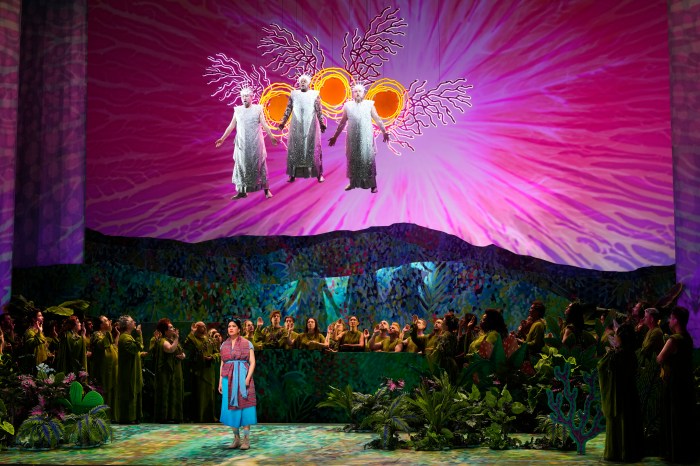With Ryan Murphy’s “Pose,” the city’s ball culture scene is back in the spotlight more than two decades after “Paris Is Burning” introduced the general public to the underground LGBTQ competition world.
Even with its major network exposure — and the help of voguing professionals like Madonna — the scene remains widely undiscovered by New Yorkers who may know little about the shimmer lighting up bars and recreational buildings in their city when the sun goes down.
“‘Paris Is Burning,’ the documentary about ball culture, came out when I was in college and it was the first version of any kind of representation of myself that I saw in the media,” actor Billy Porter, who appears in “Pose,” says.
The FX series, dubbed groundbreaking for its subject matter, plucked aspiring actors and actresses from the city’s actual ball scene to ensure the television representation remained accurate.
“It’s my life. It’s my story. It’s my community’s story … representation is key,” Porter says.
While Porter himself was an attendee of several balls in the early ’90s, his co-stars like MJ Rodriguez (Blanca Rodriguez) and Indya Moore (Angel) can frequently be found walking at the city’s current-day gatherings.
What you see when you tune into “Pose” on Sunday nights may be a fictional tale from the houses of the ’80s, but it’s rooted in a performance subculture spanning decades.
What is the ball culture scene?
Balls originated as safe gathering places in NYC for those primarily within the black and Latino communities who identified as LGBTQ. A talent competition of sorts, participants don elaborate, self-designed costumes and divide themselves into groups (or houses) to walk, dance, strut, vogue and pose their way down the runway for trophies and prizes.
These vibrant, free-spirited gatherings are led by an MC, regulated by a respected panel of judges (who have risen to a level of authority within the community) and driven by categories such as royalty, feminism and evening attire.
Prizes are given out to those who most accurately represent the night’s theme, and often stem back to one’s ability to pass seamlessly as the gender they most identify with.
Though such balls thrived in the mid-80s, they can be traced back to as early as 1869. The Hamilton Lodge Ball, held at the shuttered Rockland Palace in Harlem, was one of the city’s earliest underground ball gatherings, the details of which were kept hidden within the gay community.
As the event’s popularity grew over the years, public opposition to the balls created a boost of interest and replicas were born, spreading throughout Manhattan and giving those who felt misunderstood a place to unleash their true selves.
“Ball culture is about community. It’s about chosen family and it’s centered around the LGBTQ black and brown people who very often are rejected by their families and society,” Porter says.
Today, the ball scene thrives across all boroughs and includes gathering locations like the Christopher Street Pier, according to Porter. It has recently been depicted in films including the 2016 documentary “Kiki,” 2017’s fictional “Saturday Church” and the 2018 Vineland docuseries “My House.”
What are ball houses?
Those who compete within balls are separated into houses, which can also be referred to by the slang term “gay gangs,” according to Porter. A ball house quite literally translates to groupings of the members’ chosen relatives and closest companions.
At the center of each grouping is a mother, who the house is named in honor of. Her responsibilities range from providing housing, food, education, emotional support and discipline to making sure her house children show up to the balls in impeccable style.
One of the city’s earliest houses, House of LaBeija, was led by the late Pepper LaBeija who died in 2003, according to The New York Times. LaBeija appeared in the 1990 doc “Paris Is Burning.”
“The House of LaBeija is the legendary house, above all of them. I have the most members; I’m the most popular. I am the fiercest,” the house mother said in the film. According to the Times, LaBeija was one of Harlem’s “four great queens,” alongside Angie Xtravaganza, Dorian Corey and Avis Pendavis.
The rival nature that thrives within the houses is alive and well in “Pose,” which follows dueling house mothers Elektra Abundance (Dominique Jackson) of the House of House of Abundance, and Blanca Rodriguez (MJ Rodriguez) of the new House of Evangelista.
These houses, while fictional, were created in reflection of the city’s established gatherings.
“We get to see that this culture is resilient. This culture is thriving,” Porter says.
Ball culture terminology
Now that you’re familiar with the scene, you’ll need to know the following terms, used often within the balls.
Vogue: Made popular by Madonna’s 1990 music video, “Vogue,” the dance move refers to the pose-like rhythm of a model walking the high-fashion runway. Voguing at its core involves rapid hand and arm movements, framing the face.
Duck-walk: Voguing in “Pose” is often joined by a low to the ground walking style, which adds a level of complexity. Doing the duck-walk involves squatting low to the ground and bouncing forward while incorporating pose-like movements around the face.
Walk: You don’t walk the runway; You work the runway. The term walk refers to the overall set, whether it be voguing, dancing, modeling or a combination of all three.
Femme: A competitor, typical transgender or in drag, who achieves her look so flawlessly, she appears seamlessly feminine.
Battle: If the judges are undecided on who wins a category round, the MC calls out a battle where the two champs go head-to-head to break the tie.
House: A “gang” or grouping of chosen family members who compete against one another in the balls.
Mother: The leader of the house who provides for her “children” and is often idolized within the community.

















